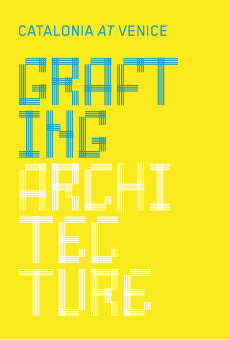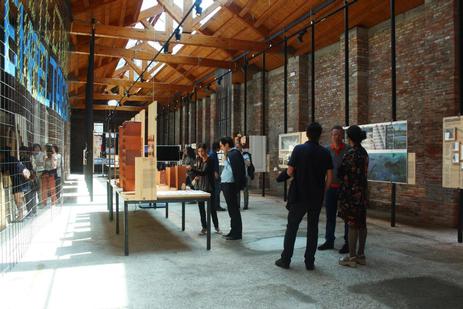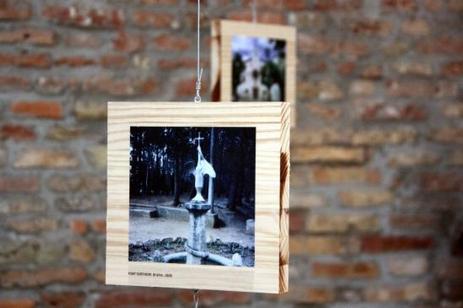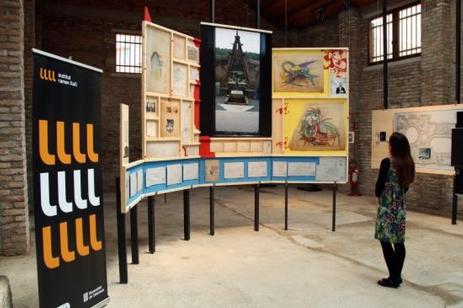Inauguration of 'Grafting Architecture' by Josep Torrents i Alegre at the Venice Architecture Biennale
This Thursday afternoon sees the opening of “Arquitectures Empeltades/Grafting Architecture”, the project that represents Catalonia at the 14th Venice Architecture Biennale within the Eventi Collaterali. The project, promoted by the Institut Ramon Llull, is curated by Josep Torrents and Alegre, with Guillem Carabí Bescós and Jordi Ribas Boldúm as assistant curators. It brings together a total of 16 works that set out to show the change in paradigm that is taking place in contemporary Catalan architecture, exemplifying a way of doing that knows how to update a living tradition, projecting it into the future.
This morning it was presented to the press by the councillors of Culture and of Territory and Sustainability, Ferran Mascarell and Santi Vila; the director of Promotion of Cultural Sectors at the Barcelona Institut de Cultura, Llucià Homs; the director of the IRL, Àlex Susanna; and the curator.
The councillor of Culture, Ferran Mascarell, stated that “architecture has been one of the fundamental elements of Catalan culture over the centuries, which gives it a continuity that can be seen in this exhibition. It pays tribute to this way of doing, of grafting a new project onto an earlier architecture, which breaks with the model in which the architect felt the need to start from scratch”. Mascarell also said that “Catalan architecture has a strong presence at this Biennale: for the Catalan pavilion, for the Catalan element in the Spanish pavilion; for parallel projects like the one from the Mies Van der Rohe Foundation or the Sorigué Foundation; and for the famous names working in other pavilions, whether as curators or as artists. It is a demonstration of the strength of Catalan architecture”.
The councillor of Territory and Sustainability, Santi Vila, believes that “it is right for Culture to promote and Territory to collaborate under the aegis of the Institut Ramon Llull in defence of the architects’ collective, one of the sectors that most excels in our country, but which has suffered from the crisis like any other”. “We share the defence of the sector; Culture, for cultural activity, and Territory, in terms of economic activity, and we want Catalonia to think in terms of architecture that is then built all over the world”, he concluded.
The director of Promotion of Cultural Sectors at the Barcelona Institut de Cultura, Llucià Homs, claims that “we understand that Barcelona acts as a capital, and therefore attracts a significant part of the culture of the whole country. That is precisely why we consider that an architecture exhibition like this one is a boost to interest in our city and its story through some of its architects of past and present”.
The director of the Institut Ramon Llull, Àlex Susanna, made a highly positive assessment of the exhibition, “and today is just the first day”. “This is an idea that is arousing enthusiasm and interest”, he added. He also pointed out that “it is a joint, a sector initiative. We are presenting a set of 16 projects for offices by architects from our country which reflect great diversity and creativity”. For him “this exhibition shows us a new paradigm and in a way illuminates what the future of architecture might be”.
The curator of the show, Josep Torrents i Alegre, explained that “at this exhibition we show different dimensions of wealth: wealth of architects, wealth of projects and wealth of attitudes. We are showing that Catalan architecture is very much alive and that our architects are well rooted in each reality and each territory. They reject standardised franchises that make the streets of so many cities look exactly the same”. On this topic, Torrents points out that “each architecture we are showing at Venice has an intense relation with the territory and culture of each place”.
Grafting Architecture: Catalonia at Venice
The proposal represents a determination to recognize, appreciate and reformulate the specificity of local Catalan architecture in contrast with the global and franchised architecture that has been dominant in recent years. The starting point is Casa Bofarull (1913-1933), one of the key works of Josep Maria Jujol (1879-1949). In this Tarragonan architect's way of working we can identify an attitude that can be traced through many projects built in the last century and which is based on an intensive dialogue with pre-existing features (physical or otherwise) that enable a project including and blending new and existing elements to be developed, just as cuttings are grafted to a tree.
Casa Bofarull allows us to explore an architectural attitude that is timeless. Accompanying it are IES La Llauna in Badalona (1984-56, Carme Pinós and Enric Miralles), Espai La Lira in Ripoll (2004-11, RCR Arquitectes and Joan Puigcorbé), and the transmitter space for the megalithic tumulus/dolmen in Seró (2007-2013, Toni Gironès), projects removed in time but very close in many ways. All of them work with pre-existing constructions and are the result of layering concepts in which traditional materials are reinterpreted, and they are inserted in the territory, engaging in dialogue. They are complex and enriching projects that add a temporary milestone to the place where they are built, and they cannot be understood without their surrounds, it being impossible to separate the parts from the whole—a rich local-universal synthesis is seen as the driving force of the project, where the world is reinterpreted from one of its corners. Projects on the slow burner and reflection continuing a long-standing architectural tradition.
The four buildings selected enable deeper comprehension of an attitude shared by other architectural examples. Thus a selection of twelve projects through which different ways of approaching different problems can be traced is being presented:
- Apartments in La Pedrera (1953-1955, Francisco Juan Barba Corsini)
- Restoration of the Church of L'Hospitalet (1981-1984, José Antonio Martínez Lapeña & Elias Torres Tur Architects)
- Caldereria Petita House in Gelida (2001-2002, Calderon - Folch - Sarsanedas Arquitectes)
- Can Framis Museum in Barcelona (2007-2009, BAAS Arquitectura)
- Juan Apartment in Barcelona (2011, Vora arquitectura)
- Auditorium of Saint Francesc Church in Santpedor (2003-2011, David Closes)
- three stations of Barcelona Metro Line 9: Amadeu Torner, Parc Logístic and Mercabarna (2008-2011, Garcés - De Seta - Bonet Arquitectes & i Ingeniería Tec-4 - Ferran Casanovas, Antonio Santiago i Felipe Limongi)
- Arenys de Munt Health Center – Can Zariquiey (2006-2013, Miàs Arquitectes)
- Cultural Center Casal Balaguer in Palma (1996 – under construction, Flores&Prats Arquitectes & Duch-Pizá)
- Vall d'en Joan landfill in Begues (2002 - under construction, Enric Batlle, Joan Roig and Teresa Galí I Izard)
- Tower with 94 subsidized housing units (2012- under construction, Josep Llinàs)
- Project to Revive and develop the area of Adhamyia in Baghdad (2012 – under construction, AV62 Arquitectos & Pedro García del Barrio & Pedro Azara).
The guiding thread of the proposal is the description of the different projects through the architectural process and the subsequent perception of the resulting building. These projects are understood from themselves, their uniqueness, and not as architecture that forms part of a movement.
The first phase describes the process used to plan and build the structure using photographs, sketches, drawings, models and so on, but never documents from the finished buildings. This phase enables understanding and discovery of the different ways of approaching this attitude, listening to the voices of the architects.The second phase emphasizes the perception of this architecture from three different perspectives. The passage of time and daily life will be captured in photographs and videos. The Actions will take place in this phase; four different artists have been chosen to reinterpret each building through an artistic action designed specifically for the space where they are to be performed.
x03z14
The show is part of the Eventi Collaterali and is open to the public until 23 Novembe

Learning Catalan
Who is Who
Grants
- Travel Assistance for Artists
- Translation of Subtitling for Films & Documentaries
- Audiovisual Presentations
- Promotion of Literature & the Humanities
- Translation Works
- Residences for Translators*
- Travel Assistance for Writers & Translators*
- Seminars in Universities*
- Illustrated works targeted to children's and youth
Catalan Culture









 twitter
twitter flickr
flickr facebook
facebook RSS
RSS spotify
spotify youtube
youtube